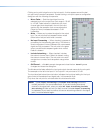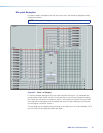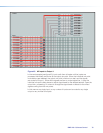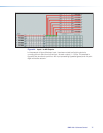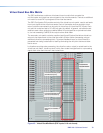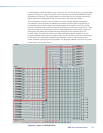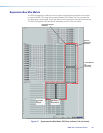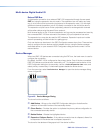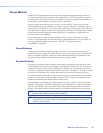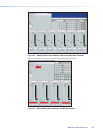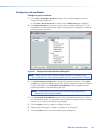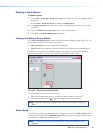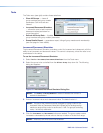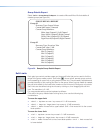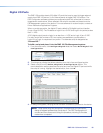
Group Masters
There are 32 Group Masters that can each be configured to simultaneously control up
to 16 group members. Group masters are configured in the DSP Configurator program
and are saved in the device. Working in emulate mode, group masters can be saved in a
configuration file and pushed to the device upon connection.
A group master can either be a gain control or a mute control. Only one control type
can be selected as group members for control by a group master. For example, a group
master can be configured to control post-matrix gain levels, but not post-matrix gains plus
input gain block. A group member can, however, be controlled by multiple group masters.
It is recommended this feature be used cautiously, as “overlapping” membership can
quickly become unmanageable.
Group master gain controls can send specific values, such as those sent by a fader
control. Group master gain can also be set by increment/decrement. For information on
using increment/decrement controls within the DSP Configurator software
(see “Tools” on page86).
Group Members
Once a group has been created, the group members — the individual controls that
comprise the group update to indicate they are now part of a group. group members can
still be controlled individually, allowing for relative levels between group members to be
fine-tuned. Group Member levels can also be set by a preset recall.
Grouped Controls
Grouping is convenient when multiple controls require muting at the same time or when
multiple signal levels need to be increased or decreased simultaneously. For example, in a
system with several audio outputs dedicated to a single room, the operator may want all
outputs to change at the same rate and at the same time. The Output 1 through 4 volume
controls can be grouped into a master that controls the volume throughout the room.
For further flexibility, individual volume controls in the group can be set for an output level
based on its use. When the group fader is moved, all four output control faders move in
tandem while retaining their levels relative to each other.
Grouped faders move together at relative levels to the top or bottom of their travel (see
figure 49, next page). If one fader reaches the limit of its travel first, it retains that position
while the other faders continue to travel. When the grouped faders travel in the reverse
direction, the fader that was at its limit reverts to its position relative to the other faders.
NOTE: If a block was previously muted when the group mute is activated, that block
remains muted when the group mute is released.
TIP: When including a control in multiple groups, do so with care. Overlapping group
membership can quickly become unmanageable. Use presets to set individual
faders to known levels.
DMP128 • Software Control 82



